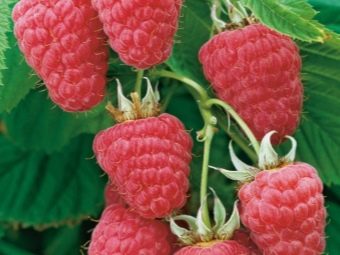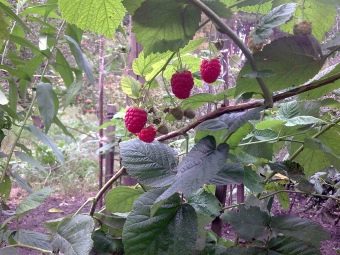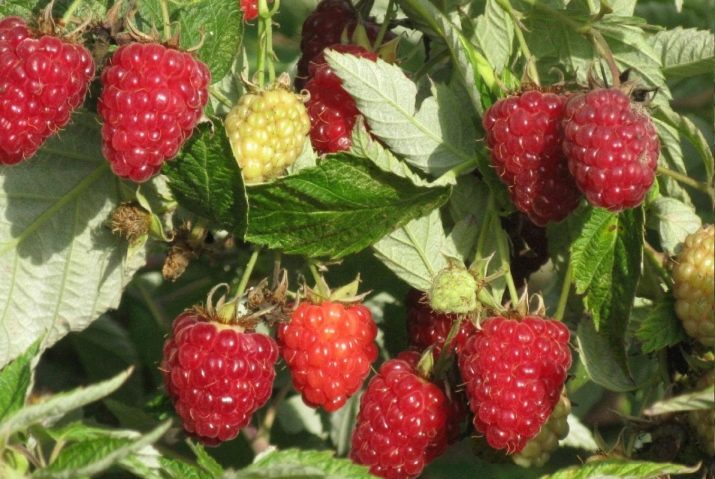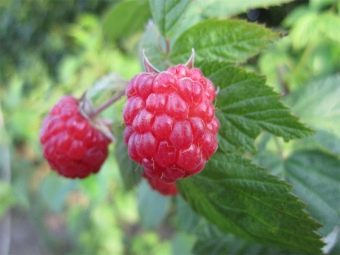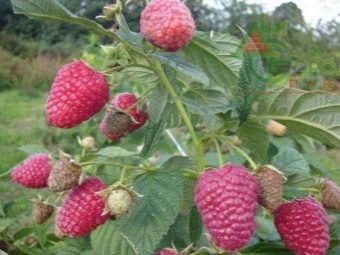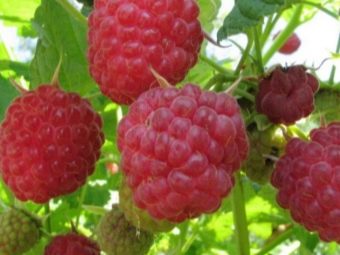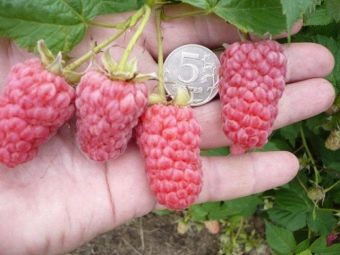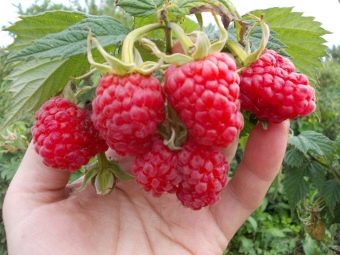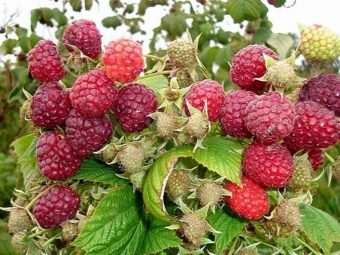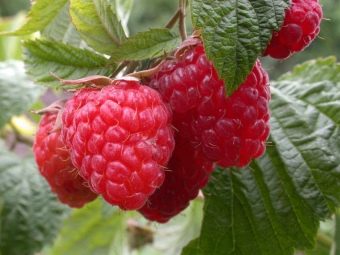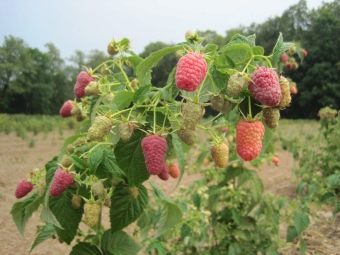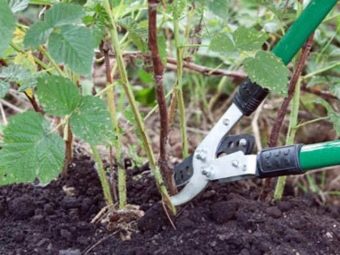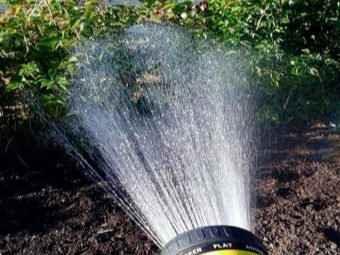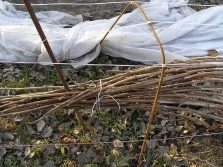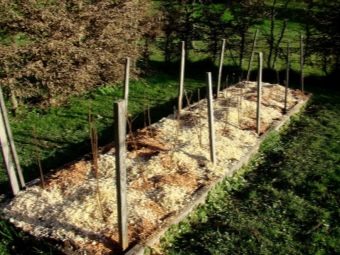Large-fruited raspberry varieties: description and reviews

Raspberries are one of the most beloved berries, especially in children.And the varieties with large fruits with extraordinary taste - even more so. In experienced gardeners, they are considered the most high-yielding due to both the growth density and the size of the berries. In addition to taste, this miracle berry is of great benefit to the body, because it has both glucose and plenty of vitamins. The smell of raspberries can not be compared with anything, everyone will recognize it.
Features and benefits
Traditionally, there are four types of raspberries. From the name of each species it is clear for what reason it bears its name.
- Standard (tree) - This is a young look that appeared at the end of the last century. People of this type are called raspberry trees because they multiply by seedlings and have the appearance of not a bush, but a trunk with branches.
- Common raspberry grows in almost every garden. In order for it to firmly hold and not to be collapsed, tapestries are necessary - wooden supports with tensioned wire or lined with slats.
- Difference remontant varieties consists in double fruiting, and in some cases continuous - for two and a half months. Thus, in one season you can get two or more yields.
- Large fruit raspberries are famous for large berries weighing from 4 to 12 grams. Thus, from one bush can collect up to four kilograms of berries. The most popular are such varieties as "Mirage", "Aborigine", "Maroseyka", "Stolichnaya".
The undoubted advantages of large-fruited raspberries include the high yield of the species, as well as the fact that with decent care the bush can bear fruit for up to 20 years. However, there are disadvantages. All large-fruited varieties are not winter-hardy, their shoots freeze slightly. Accordingly, the bush begins to bear fruit not large, but small berries.
Best of all this raspberry grows in warm regions of the country with a mild climate.However, experienced gardeners prevent freezing of shoots by gently bending the bush to the ground. Bushes of large-fruited raspberries are more susceptible to various diseases than ordinary ones. If the owner reacted inopportunely and did not immediately begin treatment, most often the infected shrub will have to be destroyed.
The stronger the plant has frozen in winter, the weaker and more susceptible it is to viruses.
Characteristic
Traditionally remontant raspberries are considered not the sweetest. However, experienced gardeners manage to achieve accumulation of sugar in its fruits. Since practically all large-fruited varieties are bred in a selection method, their taste has been improved. Sour-sweet fruits are rarely found, mainly berries are characterized by a traditional dessert flavor with a “raspberry” flavor. One of the sweetest varieties is considered "Caramel". The largest fruits are found in the varieties “Hercules”, “Daughter of Hercules”, “Moscow Giant”.
It should be noted that there are so many varieties of large-fruited raspberries that even the most demanding and picky gardener has the opportunity to choose the appropriate option.
The most perishable fruits are found in varieties of yellow raspberries. They can only be eaten, but they are not suitable for preservation, freezing and drying. As for the traditional "raspberry" raspberry, that is, dense berries that can be processed, transported, and even automated to collect, and there are melting, delicate fruits that should be eaten immediately after harvest. Among the large-fruited varieties there are both winter-hardy (for example, “Gusar”, “Senator”), and low-resistant to frost.
Winter hardiness is not the main advantage of this type of raspberry, however, later breeding varieties have improved characteristics and can withstand temperatures down to -300ºС, and some higher.
About each species
It is necessary to dwell in more detail on each of the popular varieties of large-fruited raspberries and give a brief description. About each of them there are both positive and neutral, and negative reviews, which is not surprising, because Each gardener makes a choice in favor of their individual preferences.
- Variety "Senator" distinguishes high yield and early ripening of fruits. Its bushes are relatively high and reach 180 cm, the berries are characterized as strong and large. The “senator” is winter-hardy and immune to disease.
- "Lyashka" or "Lyachka" - This is an early variety of red raspberries. He became popular not only because of the excellent taste of the fruit, but also excellent frost resistance and low susceptibility to disease. This variety is distinguished by the fact that fruits on two-year shoots. Accordingly, it requires more care. The fruits ripen in mid-June, and in the southern regions - in early June. The fruiting period lasts until the end of July. Berries are elastic, well tolerate transportation, stored for a long time.
- Moscow Giant - This is a high-yielding variety with very large berries - up to 25 g. With proper care, you can collect more than 12 kg from one bush. The berries are dense, suitable for both fresh consumption, and for canning, freezing and drying. They have a juicy taste and a real raspberry flavor. Bushes differ in height to 2 m, at the same time very compressed and perfectly developed. The period of fruiting is three weeks in July, however, since the variety is semi-repetitive, it is possible to harvest a small autumn crop. You can collect up to 6 main crops.
This variety is resistant to drought and frost, so it can be planted in a temperate continental climate.
- Variety "Phenomenon" Bred in 1991 in Ukraine, at the Krasnokutskaya Experimental Station by crossing the Stolichnaya and Odarka varieties. It bears fruit in the middle of July, it belongs to very high-yielding varieties, since up to 8 kg of fruits can be harvested from a bush. Berries are red, matte, sweet-sour to the taste. They are not showered from the bush, they are easy to collect. In the first year of planting, the shape of the fruit is more rounded, later - conical.
- Grade "Hussar" attracts the attention of the lack of spines. This raspberry is frost-resistant and high-yielding. The variety belongs to the “golden” series of Professor I. V. Kazakov from Bryansk. Such varieties as “Runaway”, “Indian Summer”, “Volnitsa”, “Peresvet”, and “Sputnitsa” also belong to this series. The variety "Gusar" is good because it gives a small number of shoots and good yields, ripens quite early. Fruits are large - up to 10 g, very juicy. Among the advantages is also its resistance to frost and diseases.
- "Brigantine" - This is a late cultivar of large-fruited, which is popular with gardeners due to its excellent taste and beautiful dark shade of berries. This variety is low susceptible to cold.
- "Hercules" got its name due to large berries that have more than 9 g. This variety refers not only to the large-fruited, but to the remontant form. The berries have a dark red color and sweet-sour taste. Due to their density, they are great for freezing, do not "limp". The high yield property allows you to get more than 3 kg from one bush. The variety is unpretentious in the care, while not very susceptible to the effects of diseases and pests. Berries begin to ripen in early August.
One of the disadvantages of the variety is a very large number of thorns. But "Hercules" is easy to propagate, as it has a lot of root shoots. In the brush a little fruit.
- Remontant grade "Daughter of Hercules" has the same advantages as Hercules. Outwardly, both varieties are very similar - the bushes are medium-high, the stems are straight, elongated berries of dark red color. Experienced gardeners believe that the fruit of the "Daughter" is larger. Berries are dense, well tolerated in transportation, amenable to freezing and processing. The variety bears fruit from August to the end of October, therefore it is considered high-yielding. He is not afraid of insects and fungal infections, does not suffer from frost.
- "Pride of Russia" - This is another variety of large-fruited raspberries with large and very large fruits - up to 18 g. This is a sweet, fragrant variety that is characterized by high yield (at least 5 kg from one bush, and with proper care even higher). The crop is medium early, the average height is up to 180 cm. The variety is moderately winter-hardy, withstands cold temperatures up to -300ºС. It is little affected by diseases and insects. Aphid does not hit this raspberry variety.
- Yellow Giant - This is a sort of yellow raspberry. His berries are dessert type. All varieties with a yellow color have very delicate fruits that retain their presentation in less than a day. That is why they will not be able to grow on an industrial scale. The berries are very sweet, fragrant, the seeds are small. Fruits should be eaten only fresh, as processing, freezing and drying are impossible. The variety is very prolific - at least 4 kg from one bush. The crop appears in the first decade of July. The height of the bushes average - up to one and a half meters. The variety belongs to remontant species, possesses well developed, but weakly sprawling bushes.
- Brigantine variety was launched at the Kokinsky strong point. Bushes are compact, represented by an average size. The crop averages 2.5 kg from one bush. The spikes are weak and not sharp, and the shoots are powerful. The variety has moderate winter hardiness, is susceptible to mycoplasma sprouting, may suffer from purple blotch.
- Shrubs variety "Mirage" are medium-sized, medium-sprawled and have an average windup ability. The spikes are soft and small. The berries are large, sweet and sour with a raspberry flavor, have an elongated shape. When ripening independently from the bush does not crumble. Winter hardiness varieties weak.
- "Giant" is one of the varieties that are considered the best for growing in garden plots. He is pretty new. Its feature is the absence of spikes. This is a very high-yielding variety, since up to 12 kg of berries can be removed from one bush. The largest fruit weighs 25 g. Caring for the “Giant” is practically no different from similar procedures with other varieties.
- "Patricia" - It is also one of the most popular varieties with large berries weighing up to 12 g. It was bred in 1986 in Moscow by crossing the variety “Maroseyka” with donor No. М102. Even if the fruits are fully ripe, they stay on the fruit bed for a long time without falling off. Berries are suitable for eating fresh, and for blanks (compote, jam, jam, candy). The first fruits appear in early July, fructifying until August. The grade belongs to the most high-yielding. It is resistant to cold, freezes at temperatures below -300 ºC, immune to disease, does not reduce the yield, if any.
- "Maroseyka" - This is the first Russian (Soviet) variety without thorns, which was bred in 1979 in Moscow, and since 1982 it has become known under its current name. Fruits are light red, fragrant, sweet, weighing up to 12 g, suitable for use in fresh and processed form. With proper care and fertilizer from one bush you can get up to 10 kg of berries. This variety bears fruit from the beginning of July until August. It is moderately winter-hardy and less resistant to pests and diseases.
- Cumberland variety - this is the only black raspberry zoned in Russia. A large number of sharp thorns are represented on the bush; shoots are arch-shaped. The Cumberland has no root offspring. The harvest is about 2 kg from one bush.
- "Freemen" reaches a height of up to 2 m. The bush has a moderate number of thorns, but due to their sharpness, it is very prickly. The harvest from one bush reaches 4 kg, the berries are medium-large, weighing 4–5 g. The fruit have a sweet-sour taste and no aroma. This variety is susceptible to raspberry mites, it is not susceptible to diseases.
- Variety "Bryansk divo" is late.Its berries ripen in mid-August. It belongs to high-yielding varieties, since it is possible to collect up to 5 kg from a bush. Fruits of medium density, fragrant, have a classic "raspberry" taste and color. Each shoot fruits more than a meter of its length. This variety was obtained by breeding due to the free pollination of interspecific form 47-18-4. Since 2006, breeding as a variety.
It grows well on an industrial scale, the berry does not wrinkle and does not flow. This variety refers not only to large-fruited, but also to remontant species.
- "Taganka" - This is a sort of late ripening. It has no thorns, the bushes are sredneraskidistymi. Fruits are large, weighing up to 10 g, dense, well tolerated in transportation, have a raspberry flavor. This variety is characterized by frost resistance, gives a good harvest - up to 5 kg from one bush.
- "Terenty" - This is another late variety, one of the newest raspberry varieties that does not have spikes. The weight of the berries varies from large to very large and can reach 15 g. The fruits tolerate transportation well and are rather dense. Berries are sweet, aromatic and juicy. With one bush you can get a harvest of up to 10 kg. The variety is frost resistant, not susceptible to fungal diseases and insects.
- "Atlant" - It is a highly productive variety that belongs to the remontant, that is, repeatedly fruitful. The bush forms shoots well, which bear fruit for more than half the length. Productivity is good and amounts to 3 kg per bush. The size of the berries reaches 9 grams, they are dense, well transported, they are convenient to collect, while they themselves do not crumble from the bush and do not rot. Fruits have a sweet and sour taste, they can be consumed both fresh and processed. You can pick berries either manually or in a mechanized way.
- "Caramel" - this is a sweet and fragrant variety, the berries taste like forest raspberries. It is very easy to collect the fruits, as they are easily separated from the stem. The average yield is 5 kg from a bush. The variety is remontant, that is, the crop ripens during the summer.
There are a lot of advantages at “Caramelka”: it can be removed by industrial mechanized method, the variety has attractive fruits that are stored for a long time. The disadvantage can be called a small number of replacement shoots, which forms a shortage of seedlings.
- Grade "Beauty of Russia" obtained in 1990 in Moscow by crossing the varieties Maroseika and Mirage. The berries of the "Beauty of Russia" are shiny, large, homogeneous, sweet, but non-aromatic. Fruits are perishable, so they should be eaten or processed immediately after collection. If you follow this rule, you can freeze, and cook, and dry the berries. The period of fruiting in a large variety - you can get up to 5 harvests per season. The variety is moderately winter hardy, drought resistant.
It has little susceptibility to typical raspberry diseases, but with poor-quality care, it can get sick with chlorosis, a mosaic of leaves, gray rot and brown spot on the leaves.
- Cascade Delight - This is a new variety that has been tested since 2012. It can be grown in private gardens and industrial plantations. Cascade Delight is an improved version of the Tulamin variety. On an industrial scale, the crop is up to 4 kg from a bush, at the summer cottage it can be twice as large. The period of fruiting is just over three weeks. The root system of the variety is very powerful, so it is not very susceptible to rotting roots.
This variety is well tolerated and prolonged rain and drought. There are very few spikes. Fruits are sweet, large, long stored on the bush, well tolerated transportation.
- "Cap Monomakh" - This is another variety bred in the Bryansk region by the breeder I. V. Kazakov. This young remontant variety bears fruit until the end of October, and sometimes even longer in southern regions. Surprisingly, the fall harvest is even greater than in the summer.To date, the fruits of this variety are considered the largest of the varieties of remontant species - up to 20 g. The taste of berries is sweet with some sourness; from one bush you can collect up to 6 kg, but not so much due to the density of growth, but because of their weight and size.
With a large number of advantages, the “Monomakh Hat” has drawbacks: if the summer is rainy or cool, the crop ripens badly, the berries sour and have a watery taste. In addition, this variety is quite demanding of the soil - it grows poorly in sour.
Selection for the region
In the northern latitudes, large-fruited raspberry varieties grow poorly, since they are not winter-hardy. Nevertheless, such varieties as “Tarusa”, “Maroseyka”, “Patricia”, and “Arbat” grow quite well in the Moscow region. They are suitable for Siberia. In the European part of Russia, where the climate is milder, with proper care, any large-fruited variety bears fruit well. In the southern regions with warm winters, problems such as freezing of shoots almost never occur.
Growing up
A raspberry is such a shrub that always surrounds many other plants, including its own shoots. For a bush, shoots are weeds that should be removed, otherwise it will take half of all the beneficial substances from the soil. Do not regret, uprooting this growth, and not think of it as a raspberry. In addition, you need to chop off all the root processes of weeds. The better all small shoots are uprooted, the better the bush is lit from top to bottom. Thus, the plant bears fruit along its entire length. Due to good lighting and uniform blowing by the wind, insects sit less on the bush, and diseases do not linger on it.
To grow a truly well-fruiting plant, you need to leave no more than 7 replacement shoots per 1 bush. In this case, even long rains will not allow the berries to rot. Fertilize raspberries with manure, urea, mineral fertilizers.
Experienced gardeners recommend using only nitrogen fertilizer at sites in the Moscow region, and it is better to discard phosphoric fertilizer altogether. Nitrogen is better to feed the plants in the fall. If the soil is rich in sand, then any fertilizer “burns” faster, so you need to fertilize more often.
An important part of plant care is top dressing in the year of planting. The first time it is carried out after the buds bloom, the second - in two weeks, and after the same time - the last. Watering raspberries should be abundant, but not excessive. An insufficient amount of water can dehydrate the plant, and an excessive amount can lead to rotting of the roots. To understand whether you need watering, you need to squeeze loose earth around a bush into a ball. If it crumbles in the hand, then water it.
One can get rid of weeds either by hand weeding or by treating the bushes with special compounds. Despite the fact that fungal diseases - didimella, leptospheric, powdery mildew - are widespread on plants, but special treatment of them large-fruited raspberries is not required, as it is resistant to them. The lack of a good and stable harvest is not talking about raspberry disease, but about poor-quality care for it. In order to avoid wormy berries, the bushes should be sprayed with karbofos or other toxic chemicals against the raspberry beetle when the bushes start flowering. In addition, treatment is necessary against the raspberry fly preparation BI-58 at a concentration of 0.5%.
Without treatment, you can lose half the crop. Treat plants need strictly according to the instructions that are attached to the drug.
Any "degeneration" of the bush is impossible, the quality and quantity of fruits depends only on the care of the plant. It is recommended to plant large-fruited raspberries only to those gardeners who are ready to take full care of it, following all the recommendations of specialists. Raspberry bushes are a kind of factories for the production of high dessert large berries. With proper care, the crop grows by itself, otherwise the gardener will immediately see where he was wrong.
Experienced Gardeners Tips
Every summer resident who grows raspberries has its own secrets. But there are several generalized tips from experts, namely:
- plant raspberries need a well-lit place. Shade it is not necessary;
- for large fruits should not be planted close to the bushes. The distance between them should be 0.5–0.7 m;
- be sure to timely trim the sprouting shoots;
- shoots are cut with a shovel to a depth of 6-8 cm;
- it is important to form a bush in time. On average, a three-year bush should have 7 or 8 replacement shoots, and be 1.5 m tall;
- for the onset of the cold season raspberries need to prepare. Leaves should be cut off, winter-hardy bushes should be bent down to the ground, and non-resistant ones should be covered;
- must be treated for insects (raspberry flies and beetles);
- unconventional advice for getting rid of excessive growth is to surround the raspberry with planting winter garlic;
- around the bushes need to mulch the soil. Peat, sawdust and even dry grass and straw can be used as mulch;
- loosen the soil should be very carefully. The raspberry root system is close to the surface, so it is extremely easy to damage;
- watering raspberries should not be on top, but at the root, on average, once a week. We should not forget about watering the bushes in the fall, after the fruiting is over, because the following year, every summer resident wants to get a good harvest.
See the next video for more details on the features of large-fruited raspberries.


